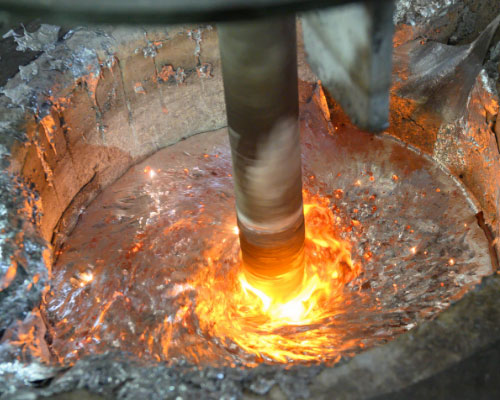Purification process of liquid aluminum alloy is the main means to improve the comprehensive properties of aluminum alloy. In the purification process, the purification gas and solvent are mixed, and the graphite rotor on the degassing equipment is used to inject the aluminum melt for purification treatment, which is the most advanced treatment method in the world.
The working principle of rotary degasser for refining is: the rotating rotor will break the nitrogen (or argon) blown into aluminum melt into a large number of dispersed bubbles and disperse them in the molten metal. Bubbles absorb hydrogen in melt and absorb oxide slag by gas partial pressure difference and surface adsorption principle. With the rising of bubbles, bubbles are taken out of the melt surface to purify the melt. Because the bubbles are fine and dispersed, they are evenly mixed with the rotating melt, and then rotate to spiral shape, slowly float up, and contact with the melt for a long time, so the gas flow generated by continuous straight-line rise will not be formed, thus the harmful hydrogen in aluminum melt can be removed, and the purification effect can be significantly improved.

Purification Process of Liquid Aluminum
There are many die casting and casting equipment for melting aluminum alloy in the market, including centralized melting furnace, crucible furnace, pool furnace, electric holding furnace, etc. Therefore, degassing equipment can also be customized according to aluminum alloy smelting equipment, which can be made into mobile refining degasser, fixed refining degasser and suspended refining degasser.
There are three states of hydrogen dissolved in molten aluminum (atomic state molecule and compound state, in which only hydrogen molecule may form pores, hydrogen molecule and hydrogen atom are in dynamic equilibrium state, and hydrogen molecules and hydrides separate out in different forms in the process of metal crystallization immediately (hydrogen atoms disperse to the metal surface and then leave the adsorption state, and hydrogen molecules are evaporated to remove hydrogen from the liquid metal in the form of bubbles) When some of the bubbles fail to float up to the interface, they will stay in the molten metal and cause Blowholes in the casting.

